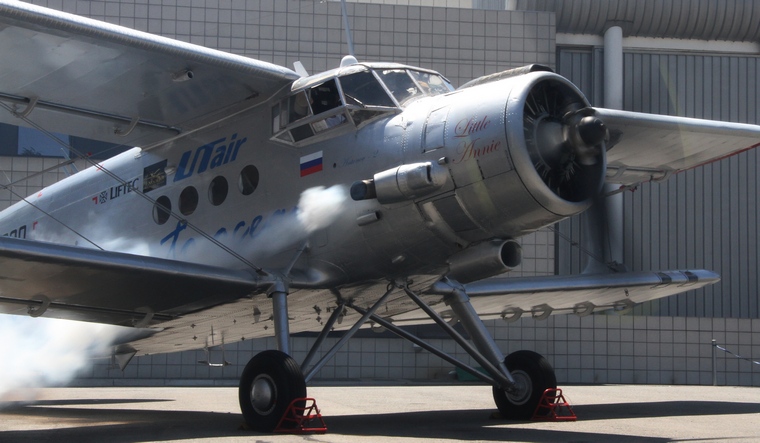The Epic Journey of the Antonov AN2 - Little Annie
By Garth Calitz & WIllie Bodenstein
On the 5 December 2012 the go ahead was received for the immaculate Antonov AN2 to finally set off on the longest ferry flight in history. Plekhanovo airfield in Siberia, Northern Russia, was their departure point in temperatures of -20deg C. “Annushka”, as she is affectionately known in Russia and translated as “Little Annie”, left for an adventure of a lifetime. Their journey would take them through 15 different countries on three continents and through some of the most extreme flying conditions known to man.

The chosen route took them from the shores of the Arctic Ocean through Russia to the Ukraine. All the fuel and oil requirements for this leg of the flight was provided by UT-Air Aviation, the current owners of the aircraft. From the Ukraine they travelled through Europe via the Czech Republic, Germany, France and Spain. ExecuJet Europe took over the backup role for the European leg. Even in Europe, this was quite a challenge. With an endurance of no more than 7 hours and a cruising speed of 130knts the AN2 had to make regular landings to refuel.

Europe gave way to Africa as they crossed the Mediterranean Sea at Gibraltar to Algeria, and with the change of continent came a change in climate. During the African leg of the epic journey they travelled through Algeria, Niger, Nigeria, Cameroon, Equatorial Guinea, Gabon, Congo, Angola, Namibia, Botswana and on to South Africa. ExecuJet Africa took care of all their needs throughout Africa often having to perform near miracles to keep the project airborne. “Africa is not for Sissies”, operating in temperatures of over 40 deg C, Little Annie kept going all the way to Cape Town.

The crew consisted of Pilot Sergey Bykov, a flight instructor with over 5200 hours on the AN2 built up over his 37 year career, navigator Sergey Dmitrenko, also an AN2 type rated pilot from Leningrad and Alexander Achimov as flight engineer. In the Ukraine the crew grew from three to five, when they were joined by British Pilot Tracy Curtis-Taylor, Mark Hill to pilot the aircraft once based in South Africa. Mark was trained in the South African Air Force and has over 11000 hours of which 3000 are tail dragger hours. He is currently working as a commercial pilot in Central and Southern African nations.

I was fortunate to meet up with “Little Annie” at her stop over at Lanseria Airport on the Tuesday 21 February two and a half months into a journey that was planned to take only fifteen days. The crew had to endure many delays, fortunately not many due to technical problems. Close to six weeks were lost due to African bureaucratic red tape and the unavailability of Avgas. The whole mission was halted in Nigeria as Gabon refused to let the aircraft enter its airspace, probably due to the bad safety record of African operated Antonov aircraft in Gabon.
ExecuJet Africa had to call in many favours throughout the African leg of the flight just to get fuel to the designated refuelling points, sometimes arriving long after the AN2. In Angola the military was called on to help deliver the fuel with an Illusion IL76 as clearance for the support aircraft could not be obtained. The Namibian government refused to clear the AN2 through their airspace. The original plan was to fly from Namibia to Cape Town but due to this restriction, the flight was diverted to Johannesburg. With the benefit of hindsight the crew concede that taking the eastern African route may have been a better option.
“Little Annie” will take residence at Wonderboom Airport as soon as the import procedure is completed, where she will be operated by ExecuJet Aviation group and used on charity missions to introduce orphaned children to the joys of flight and in the process promote aviation awareness amongst the youth of Southern Africa.

The former Soviet design bureau OKB Antonov now (Antonov ASTC, Ukraine) celebrated their 65th Anniversary last year and this historic “Coast to Coast” project was designed to be part of the celebrations. The crew were treated to a vist to the Antonov factory while they were in Kiev. The first Antonov aircraft too take to the skies, Incidently an AN2 , was first flown in Novosibirsk on 31st August 1947. The Antonov AN2 is powered by a 987hp Shvetsov ASh-62IR Radial engine, with an average fuel burn of 180lt per hour and uses anything between 3,5 and 5,5lt of oil per hour. With a wingspan of 18 m and a length total of 12,74m she holds the honour of being the largest single engine Bi-plane ever built. It is the only aircraft in the world which has been produced for more than half a century, and this has earned it a place in the Guinness Book of Records as the most popular aircraft in the world. In total more than 20 000 AN2 aircraft have been produced. “Little Annie” was manufactured in Poland on 3 September 1987 and designed to carry 1600kg cargo or 12 passengers.
 
A very big South African welcome to “Little Annie” and we all hope to see you gracing our skies for many years to come.
|
      |























